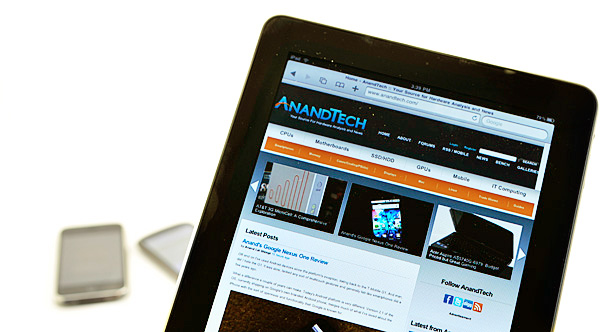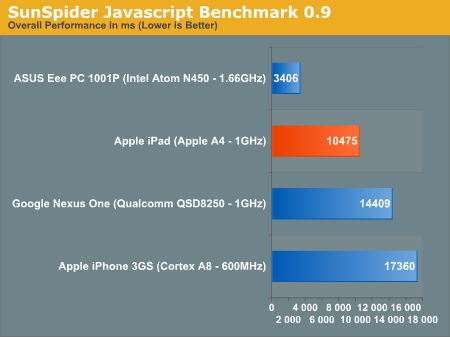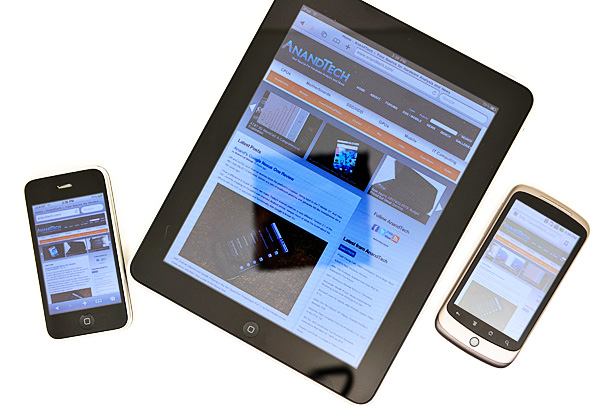Apple's iPad A4 SoC: Faster than the Nexus One's Snapdragon?
by Anand Lal Shimpi on April 3, 2010 3:52 PM EST- Posted in
- Smartphones
- Mobile
Fresh out the frying pan and into the fire, I just finished my Nexus One review late last night only to have my iPad preorder show up early this afternoon. I had been preparing for it's arrival not by downloading apps but by figuring out what comparative benchmarks I wanted to run on the iPhone 3GS and Nexus One.

As the first device to use Apple's A4 SoC I wanted to see how it stacked up against the Cortex A8 and Qualcomm's QSD8250. All three chips appear to be dual issue in order architectures with varying pipeline depths, clock speeds and cache sizes.
At 600MHz the Cortex A8 in the iPhone 3GS is the slowest out of the bunch. The Snapdragon is much faster as we just established thanks in part to it's 1GHz clock speed. But what about Apple's 1GHz A4?

There's very little we know about the A4 other than it's operating frequency. It is manufactured by Samsung but on an unknown process node. Jon Stokes recently stated that Apple's secrecy surrounding the chip is because it isn't anything special, just a Cortex A8. If that is true, I suspect that it would have to be manufactured at 45nm in order to reach such a high clock speed.
With a new silicon mask there's also the chance that Apple moved to LPDDR2 to boost memory bandwidth; a change that most SoC makers are planning to make this year.
So how does Apple's A4 stack up against today's favorite smartphone brainchild? Keep in mind that these results are generated by running two different OSes (Android 2.1 and iPhone OS 3.2) and two different browsers. What we're looking at is the performance delivered by the combination of the CPU and the software stack:
| Applications Processor Performance | ||||||
| Apple iPad (Apple A4) | Apple iPhone 3GS (ARM Cortex A8) | Google Nexus One (Qualcomm Snapdragon QSD8250) | % A4 Faster than Snapdragon | |||
| Load www.anandtech.com | 6.2 seconds | 9.3 seconds | 8.8 seconds | 41% | ||
| Load www.digg.com | 10.6 seconds | 18.0 seconds | 11.5 seconds | 8.7% | ||
| Load www.tomshardware.com | 7.9 seconds | 13.9 seconds | 8.6 seconds | 8.7% | ||
| Load www.arstechnica.com | 7.8 seconds | 13.8 seconds | 11.0 seconds | 39.9% | ||
| Load www.legitreviews.com | 6.8 seconds | 12.3 seconds | 8.6 seconds | 26% | ||
| Load www.techreport.com | 3.7 seconds | 7.4 seconds | 4.2 seconds | 11.6% | ||
| Load www.engadget.com | 13.8 seconds | 22.8 seconds | 22.0 seconds | 59.4% | ||
| Load www.gizmodo.com | 14.1 seconds | 21.4 seconds | 16.7 seconds | 18.5% | ||
| Load m.cnn.com | 3.0 seconds | 6.0 seconds | 2.6 seconds | -11.8% | ||
Unless otherwise specified, I loaded the full version of all of the websites above (the exception being CNN, where I used the mobile site). To ensure reliability, I ran all of these tests at least 5 times, threw out any outliers and averaged the rest. The rests were also run at around the same time to ensure that content on the sites was as similar as possible (and thus shouldn't be compared to this morning's Nexus One results). You'll note that the Engadget results are a bit odd. It looks like the iPhone and Nexus One scores are bottlenecked somewhere else (there seemed to be some network issue plaguing the loads, but it wasn't present on the iPad), but if you toss out the very large differences you end up with what I believe to be the real story here. Update: Flash wasn't enabled on any device (not supported on iPad/iPhone, not officially available on Android yet), and all three devices connected to the same WiFi network. The Apple devices used mobile Safari, while the Android device used the Android Browser. Both are WebKit based but there are obvious, unavoidable software differences.
Removing the AnandTech, Ars Technica and Engadget loads (which were repeatable, but unusually long) the iPad loads web pages 10% faster than the Nexus One. If you include those three results the advantage grows to 22.5%. I'd say somewhere in the 10% range is probably realistic for how much faster the A4 is compared to the Snapdragon.
I also ran the official WebKit SunSpider JavaScript Benchmark on all three platforms to give us a network independent look at real world JavaScript performance:

If we take the network out of the equation, the A4 in the iPad has a 37.6% performance advantage over the Qualcomm QSD8250. This actually supports some of the larger performance differences we saw earlier. If Apple can manage to deliver this sort of performance in its smartphone version of the A4, we're in for a treat.
The why is much more difficult to ascertain. It could be as simple as the the iPad OS being better optimized than Android, a definite possibility given how much longer Apple has been working on it compared to Google. The advantage could also be hardware. The A4 may boast higher IPC than Qualcomm's Snapdragon thanks to better core architecture, larger caches or a faster memory bus. The likely case is somewhere in between, where the iPad's advantage comes from a combination of hardware and software.

It could also be a power optimization thing. The A4 in the iPad is paired with a much larger battery than the QSD8250 in the Nexus One, Apple may be able to run the SoC at more aggressive performance settings since it doesn't have to worry about battery life as much. Either way the one thing we can be sure of is Apple's A4 SoC is much more like a 1GHz Cortex A8 rather than anything more exotic. Good work Jon :)
I should note that while the performance improvement is significant, it's not earth shattering. Despite the early reports of the iPad being blazingly fast, I found it just "acceptable" in my limited time with it thus far. I'll go into greater detail in my full review later.
This does bode well for the upcoming 4th generation iPhone, which is widely expected to also use the Apple A4 SoC. That upgrade alone should put the next iPhone ahead of Google's Nexus One in performance, assuming that it offers the same performance as it does in the iPad. Pair it with a modernized and feature heavy iPhone OS 4.0 and we might see an Apple answer to Android in 2010.
The A4 is particularly exciting because it combines Snapdragon-like CPU performance with a PowerVR SGX GPU. A much better option than the aging ATI core used in Qualcomm's QSD8x50 series.
With Apple showing its A4 performance this early, Qualcomm also has a target to aim at. The first single-core 45nm Snapdragon SoC due out in 2010 will run at 1.3GHz. That could be enough to either equal or outperform Apple's A4 based on what we've seen here today.
Expect our full review of Apple's iPad as well as more discussion about the A4 next week. Have a great weekend guys.










159 Comments
View All Comments
EarthwormJim - Saturday, April 3, 2010 - link
The iPad is essentially a phone SOC with a big battery and big screen. It's even running a phone OS. It's like comparing the iPhone to the Nexus One. They're all ARM variants too. They're also both priced similarly. It's perfectly valid to compare their web page rendering speeds. It also can be a nice preview comparison of what the next iPhone will be like speed wise.I wouldn't mind seeing a comparison between a similarly priced ultra-portable or netbook in this iPad review of similar tasks (like web page loading).
Anand Lal Shimpi - Sunday, April 4, 2010 - link
Don't spoil the surprise :-x:)
Take care,
Anand
Fleeb - Sunday, April 4, 2010 - link
Atom?LuxZg - Sunday, April 4, 2010 - link
Than we'll wait for a full review, as I believe that size/price comparison puts it closer to (at least) netbooks than it does to phones..Alexstarfire - Sunday, April 4, 2010 - link
"It's like comparing the iPhone to the Nexus One."And that is my point exactly. This is comparing one platform to another, not CPU vs CPU. I've got no qualms with them comparing an iPad to a phone, although I think it's stupid since it should obviously be at least a bit faster. My issue is that they are trying to compare CPU vs CPU in which case they simply can't. There are far too many variables to find anything even remotely definitive.
EarthwormJim - Sunday, April 4, 2010 - link
I understand what you're saying. You're right, CPU to CPU is basically impossible to do.tim851 - Monday, April 5, 2010 - link
Whenever you are comparing an AMD CPU to and Intel CPU you are also comparing platforms. Doesn't usually bother anyone.People also compared PowerPC Macs to x86-PCs, where you had completely different architectures with completely different OS'es running different compiles of Photoshop and they were interpreting the results.
All of this might be methodically wrong, but it's still kind of interesting. Although pointless in the end. Because a purchase decision for the iPad won't likely be made upon performance considerations.
zdzichu - Saturday, April 3, 2010 - link
Dissappointing. CPU speed is compared based on benchmarks with diferent versions of software.Griswold - Saturday, April 3, 2010 - link
I have to agree and he even says it himself. Why compare a device with a 25Wh akku to a smartphone that has to work with much, much less capacity and thus more strict power envelope? Its like going to a gunfight with a knife...And then the whole software difference. Pointless from start to end.
Bottom line is, I dont expect my smartphone to perform on par with a 1.5 pound device.
WaltFrench - Sunday, April 4, 2010 - link
Pointless?What *would* have had a point absent a tear-down or architectural description?
If nothing else, the article shows that, if you're sitting at home with your iPad next to your Nexus phone, you can get pages on the iPad a couple of seconds faster. Despite a couple times the pixels that get driven. Despite claims of virtually identical clock speed, which is all that many people understand about CPUs, and almost all that we officially know about the A4. Despite the work that Google has done on Webkit.
If none of that is relevant, what drew you to go past the headline?